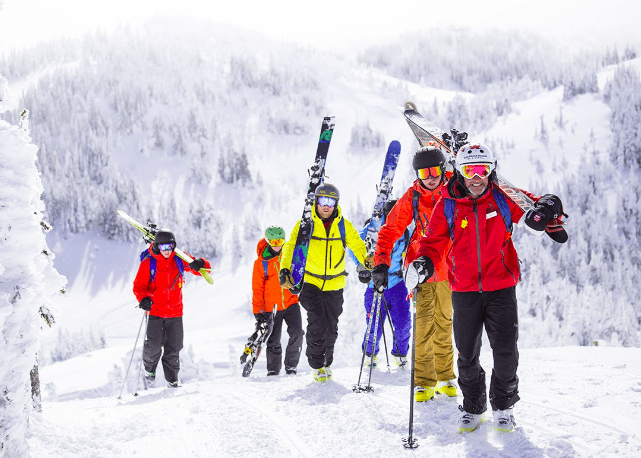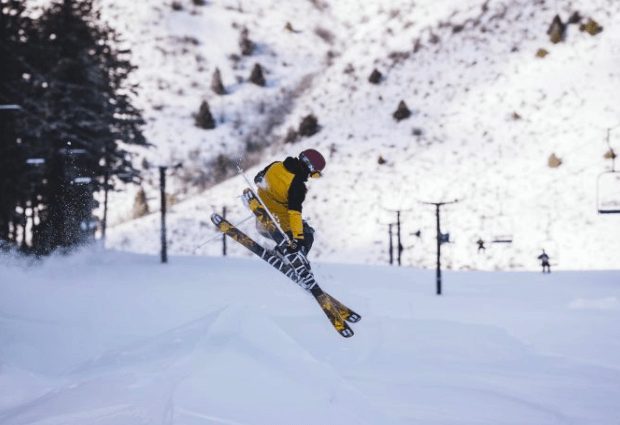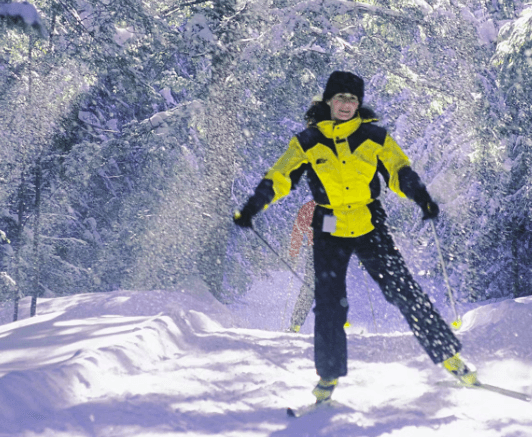
How to prepare for skiing.
Preparing for a ski trip is an exciting endeavour that promises thrills, stunning mountain scenery, and the pleasure of gliding across snow-covered slopes. Whether you’re a seasoned skier or a first-timer, going on a ski excursion involves careful planning and consideration of numerous factors to guarantee a safe, pleasurable, and memorable experience.
This guide will walk you through the steps needed to prepare for a ski journey of a lifetime, from choosing the ideal place and acquiring necessary equipment to sharpening your skiing abilities and experiencing the wonder of winter. So, lace up your boots, grab your ski poles, and prepare to dive into the world of skiing as we begin on this full voyage of preparation for your next snowy adventure.
How to prepare for the best ski adventure

Preparing for the greatest ski vacation requires a mix of preparation, equipment preparedness, physical fitness, and location knowledge. Here are the crucial elements to making your ski trip an unforgettable experience:
Choose the Right Destination:
Select a ski resort or area based on your ability level and skiing preferences (e.g., downhill, cross-country, backcountry).
Consider the topography, the snow conditions, and the diversity of slopes accessible.
Make your travel plans:
Book your lodgings well in advance, especially during high season.
Arrange for transportation to the ski resort, whether by car, plane or rail.
Gather the Required Equipment:
Check the condition of all your skiing equipment, including skis, bindings, boots and poles.
Rent or buy whatever equipment you don’t already have, such as helmets or avalanche safety equipment for backcountry skiing.
If required, get your equipment professionally calibrated and adjusted.
Dress Appropriately:
To be warm and dry, dress in layers. Moisture-wicking base layers, insulating midlayers, and waterproof outerwear are all recommended.
Wear moisture-wicking ski socks and ski boots that fit properly.
Don’t forget about essentials like ski gloves, goggles, and a helmet.
Physical Preparation:
Begin a workout plan before your trip to increase your strength and endurance.
Skiing may be physically taxing, so focus on leg strength and cardiac fitness.
Ski lessons (if necessary):
Consider taking ski lessons if you’re a novice or haven’t skied in a long time to enhance your abilities and confidence.
Understand the Ski Area:
Study the route map and become acquainted with the ski resort’s layout.
Check the trail difficulty ratings and ski to your ability level.
Preparedness and safety:
Ski safety requirements should be learned and followed.
Take an avalanche safety course and carry the essential safety equipment if skiing in the backcountry.
Weather Preparation:
Check the weather forecast for your location and be ready for changes.
Dress with layers that you may remove or add as required.
Pack Essentials:
Bring sunscreen, lip balm, water, snacks, and a basic first-aid kit.
Remember to bring your ski pass or lift ticket.
Keep Altitude in Mind:
When skiing at high elevations, be aware of the possibility of altitude sickness and take precautions to acclimatise.
Environmental sensitivity:
Follow the principles of Leave No Trace and be responsible by not littering and appreciating nature.
Travel Insurance:
Consider obtaining travel insurance to protect yourself against unanticipated incidents or crises.
Relax and have fun:
Remember that skiing is about having fun as much as skill. Take some time to unwind and appreciate the environment.
Stay Updated:
Keep a look out for resort updates, trail conditions, and safety warnings.
By following these procedures and being well-prepared, you will boost your chances of enjoying the finest ski experience possible. Skiing is not only an exciting activity, but it also allows you to appreciate the beauty of winter landscapes and make memorable memories.
What do i need for skiing?

Skiing is a fun winter activity, but correct equipment and gear are required to assure your safety and pleasure on the slopes. Here is a complete list of things you will need for skiing:
Skis:
The primary piece of skiing equipment, which should be suited for your ability level and kind of skiing (e.g., downhill, cross-country, or backcountry).
Ski Bindings:
These connect your ski boots to your skis and should be properly adjusted based on your ability level and preferences.
Snow Boots:
Ski boots that are properly fitting are essential for control and comfort. They should be able to work with your bindings.
Ski Poles:
Used for propulsion, turning, and balancing. Poles should be adjusted to your height.
Goggles for skiing:
Sun, wind, and snow should all be avoided. Select lenses that are suited for the lighting circumstances.
8 Benefits of Using a Goggle Ski and How To Choose The Best Goggle Ski.
Helmet for skiing:
A must-have for safety. It protects your head in the event of a fall or impact.
Ski Jacket:
A jacket that is waterproof and insulated to keep you warm and dry.
Ski Pants:
Pants or bibs that are waterproof and insulated to keep your lower body warm and dry.
Base Layers:
Thermal underwear that wick moisture and regulate body temperature.
Mid-Layer:
For extra warmth, add an insulating layer, such as a fleece or down jacket.
Socks for skiing:
Warm, moisture-wicking socks that go all the way up to your calves to prevent chafing.
Mittens or ski gloves:
Gloves or mittens that are insulated and waterproof to keep your hands warm and dry.
Balaclava or Neck Gaiter:
Keep the cold and wind off your neck and face.
Beanie or Ski Hat:
Maintain a warm head, especially if you are not wearing a helmet.
Snow Gaiters:
These are used over your ski boots to prevent snow from entering.
Backpack for skiing:
For transporting necessities like as food, drinks, and additional clothing.
Lift Ticket or Ski Pass:
Access to ski resorts is required.
Transceiver:
Used to find others in the event of an avalanche.
Sunscreen:
Use sunscreen to protect your skin from UV radiation, especially at high elevations.
Lip Gloss:
Prevent chapped lips in cold and windy weather.
Water and snacks:
Maintain your energy levels by eating high-energy snacks and staying hydrated.
First Aid Supplies:
A compact first-aid kit for minor injuries.
Backcountry skiers must use a map and compass or GPS to navigate securely.
Mobile phone:
Keep it fully charged in case of an emergency.
Before hitting the slopes, make sure your equipment fits properly and is well-maintained. Additional goods may be required based on your skiing style, region, and preferences, but this list should cover the essentials for most skiers. To have a safe and pleasurable skiing experience, always observe safety recommendations, obey resort laws, and be conscious of your ability level.
FAQs About Skiing
What exactly is skiing?
Skiing is a winter activity that entails sliding down snow-covered hills on specialised skis. Skiers regulate their speed and direction by moving their bodies.
What are the different types of skiing?
Skiing is classified into several forms, including alpine (downhill) skiing, cross-country skiing, freestyle skiing, and backcountry skiing. Each style provides a distinct skiing experience.
What skiing equipment do I need?
Skis, bindings, boots, poles, and suitable apparel such as a helmet, ski jacket, trousers, gloves, and goggles are all required. Depending on the style of skiing, you may require different equipment.
How do I select the best ski equipment?
Ski equipment must be properly fitted. Visit a professional ski store for expert help, and when making your decisions, keep your ability level and skiing style in mind.
Is it tough to learn to ski?
Skiing can be difficult for novices, but most individuals can become excellent skiers with training and practise. It is advisable to begin with classes and advance at your own speed.
How can I keep myself safe when skiing?
Follow all safety precautions and resort regulations. Wear a helmet, keep within your ability level, and pay attention to your surroundings. Take avalanche safety classes and carry the essential safety equipment if skiing in the backcountry.
What should I wear for skiing?
To be warm and dry, dress in layers. Moisture-wicking base layers, insulating midlayers, and waterproof outerwear are all recommended. Wear moisture-wicking ski socks and accessories such as gloves and goggles.
What is the best time of year for skiing?
The optimum time to go skiing is determined on your location and tastes. Most ski resorts are open throughout the winter season, with the busiest months being December through March. However, several areas also provide spring skiing.
What are some popular ski resorts?
Aspen and Vail in Colorado, Whistler in Canada, the Swiss Alps, and the French Alps are also popular ski resorts. There are other fantastic ski resorts in many parts of the world.
Is skiing a costly sport?
Skiing may be costly, especially when lift tickets, lodging, and equipment are included. There are, however, more affordable choices, and many resorts offer bargains and packages.
Can I ski if I’m not in great physical condition?
Skiing is a physically hard sport, but you don’t have to be in top shape to enjoy it. It’s critical to be physically healthy and aware of your own limitations.
Is there an age limit for skiing?
Skiing is a sport that may be enjoyed by individuals of all ages. Ski schools frequently provide instruction for both children and adults, and many elderly people continue to ski.
How can I pick the best ski resort for my ability level?
Examine several ski resorts’ trail maps, reviews, and offered services. Many resorts have a selection of trails from which to pick according on your ability level.
Can I rent ski equipment rather than buy it?
Yes, most ski resorts and rental companies rent ski equipment. Renting is a convenient choice, particularly for novices or infrequent skiers.
What are the advantages of skiing for health?
Skiing is a great way to get some aerobic exercise, improve your balance and coordination, and work out different muscle groups. It’s an excellent way to keep active during the winter.
Related
- 8 Benefits of Using a Goggle Ski and How To Choose The Best Goggle Ski.
- 16 Best Vancouver’s Great Outdoors: A Playground of Adventure and Natural Beauty”
- Best Ski Resorts To Visit In Nova Scotia: Canada’s Hidden Winter Gems.
- 10 Best Cannabis-Friendly Ski Resorts in the USA. Slopes and Spliffs!!
- What Are The Best Ski Resort In New Mexico? When Do They Open?






